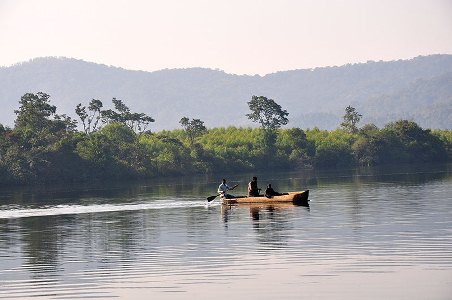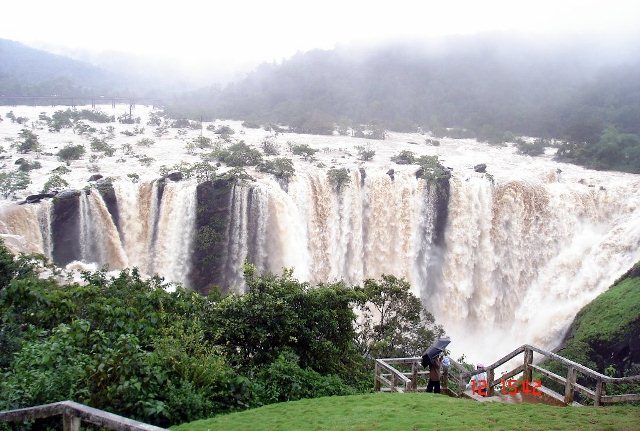It depends pretty much on your timing when you plan to visit the Natural wonders of india; whether it would be a coral reef in lakshdweep or a shola forest, nilgiri. If you are on the way to plan; “the wild wonderland of sahyadris, the highest plunge-fall in India, the Jog falls” is the perfect tourist destination.

Majorly a river, Sharavati originates at a place called Ambutheertha, flows westwards and it joins the Arabian Sea at Honnavar. This place holds its importance in Hindu Mythology, it is said that during the Ramayana it was here that Lord Ram broke the bow to win the hand of Sita.

Watch nature’s beauty unwind as Sharavati plummets from a dizzying height creating the Jog Falls. One can witness nature’s headlong tumble, in four distinct cascades – known locally as Raja, Rani, Roarer and Rocket – to create the fifth highest falls in Asia and is the second-highest plunge waterfall in India. One of India’s greatest scenic wonders, with arching rainbows colouring the mist, the Jog Falls is at their exuberant best during the monsoon.
Tucked amidst the lush greenery of the Western Ghats along the expansive Sharavati backwaters, is a small village perched on the hills that overlook the Linganamakki Reservoir. Here lies a small island that attracts campers, which also happens to be a birdwatchers paradise; and one can also find a large variety of butterflies.
A precious jewel in the tiara of Karnataka’s splendor, the Sahyadris abound with natural bounties. With verdant valleys, gushing rivers, luxuriant grasslands and a significant forest cover they are a treasure trove of rare flora and fauna, many of which are endemic to this region. The Sahyadris sport their most vibrant attire during the monsoons when new life burgeons in every nook and corner of its expanse. Hear the twittering of the birds and the gushing of the crystal clear springs with rejuvenated energy after the monsoon.
Those looking for a “Wild Adventure” can easily head to Sharavathi as it combines the grandeur of plush mountains with abundant wildlife. One can watch out for a snug place tucked on the slopes of a hillock skirting the Reservoir to pitch their tent in/ find a campsite. It is a great place to revere the energizing mélange of sunshine and rain. Every season brings a new reason to visit these salubrious mountains. It is an ideal location to experience the exemplary magic of the monsoons. After the rain-laden clouds have moved on, the weather is conducive for outdoors. In nature walks amidst bird talks you can savor the pastoral calm of the surroundings. You can chase butterflies as they flutter from bud to blossom and leaf to leaf. Drifting along the refreshing blue waters of the reservoir you can indulge a refreshing dip while you can watch the sun paint the sky with shades of soft orange and transform it into dazzling strains of crimson. You can wake up to misty mornings and head out for a drive into the densely wooded forest of the Sharavati Valley Wildlife Sanctuary. The sanctuary encompasses a part of the Sharavathi river basin and has evergreen and moist deciduous forests. At the Sharavathi Adventure Camp you are cradled in nature’s lap and left to enjoy the ethereal beauty of the Sahyadris.
A few Facts on its Flora, Fauna and landscape

A part of the Sharavati river basin was declared as a wildlife sanctuary on 20 April 1972. Spread over an area of 431.23 km2, it has dense evergreen and semi-evergreen forests. Linganamakki reservoir spread over an area of 128.7 km2 is a part of this sanctuary. The remaining area has been divided into core zone, buffer zone and tourism zone. The altitude in the sanctuary varies from 94 to 1102 mts, the highest point being Devarakonda on the southern edge of the sanctuary. Temperatures range from 15° to 38 °C and mean annual rainfall is 4500 mm.
The sanctuary has mainly evergreen, semi-green and some moist deciduous forests. The sanctuary is a refuge of the endangered Lion-tailed macaque. Other mammals include tiger, leopard (black panther), wild dog, jackal, sloth bear, spotted deer, sambar, barking deer, mouse deer, wild pig, common langur, bonnet macaque, Malabar giant squirrel, giant flying squirrel, porcupine, otter and pangolin. Reptiles include king cobra, python, rat snake, crocodile and monitor lizard. Some of the avian species found in the sanctuary include three species of hornbill, paradise flycatcher, racket-tailed drongo and Indian lories and lorikeets. There are also about 23 amphibians recorded here of which 15 species are endemic to the Western Ghats.
This is how abundantly rich the Shravati river basin’s biodiversity is. If you get a chance then please be sure to visit this Wild Wonderland.
Season
The south-western rainy season starts in June and lasts until November. In the period of the monsoons, the Western Ghats are soaked in rain that renews new lifespan and freshness. This is the best time to visit the Sharavathi River & Jog Falls.